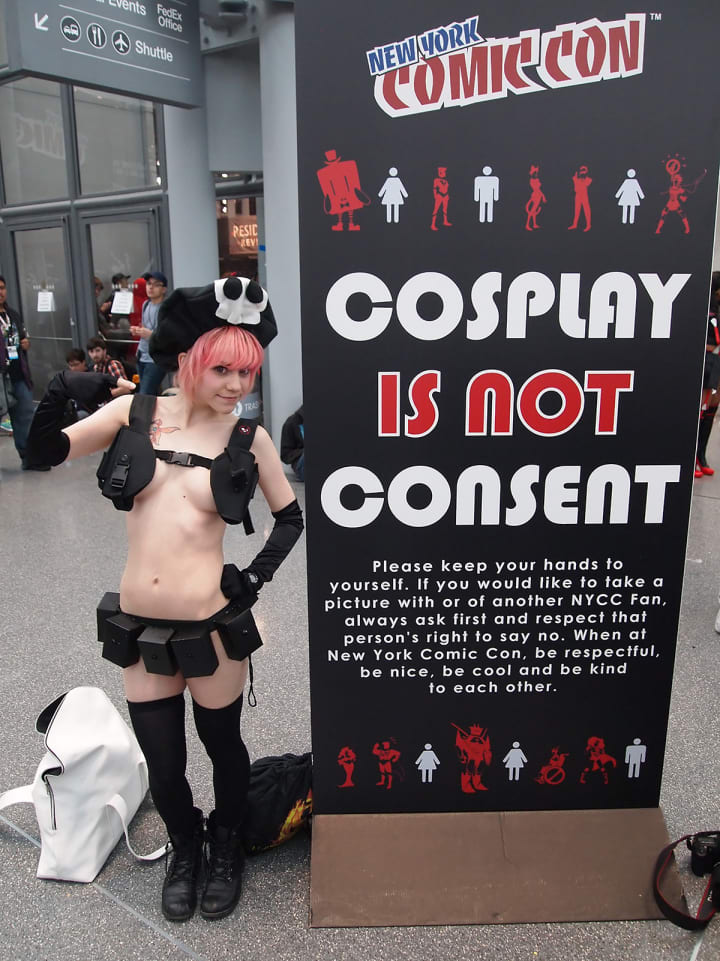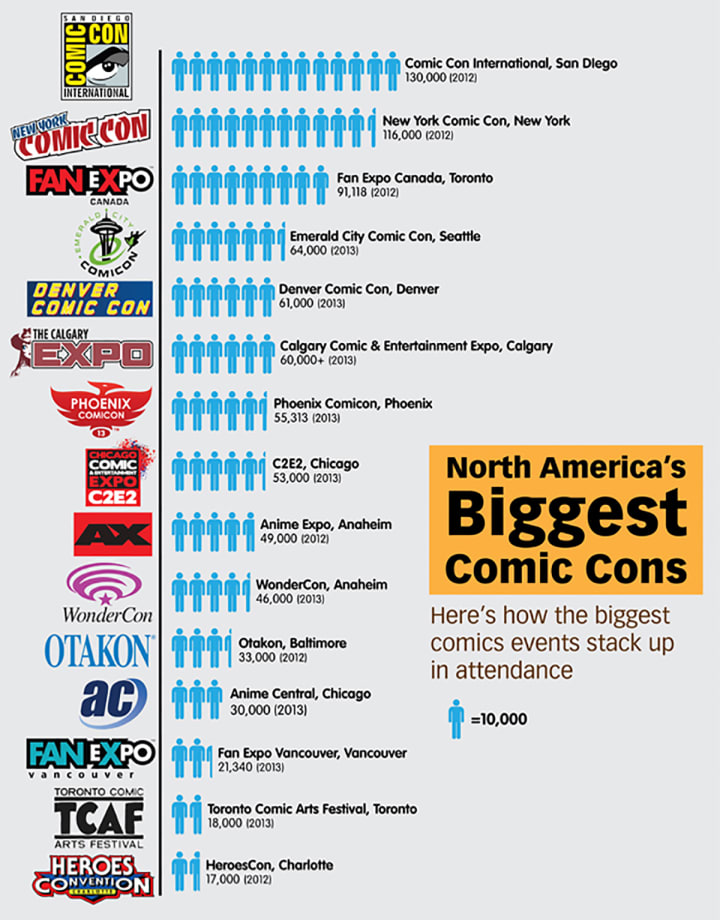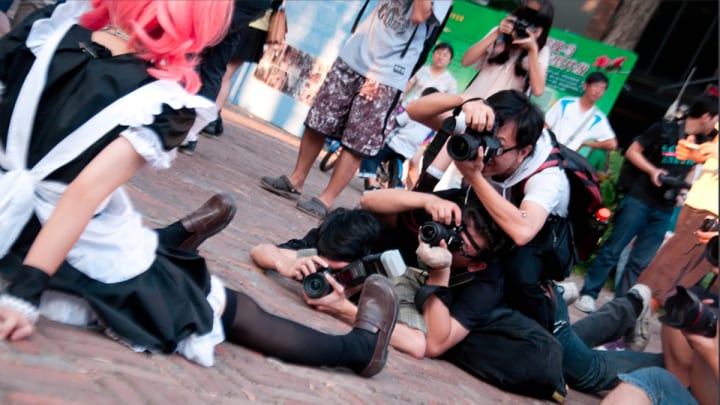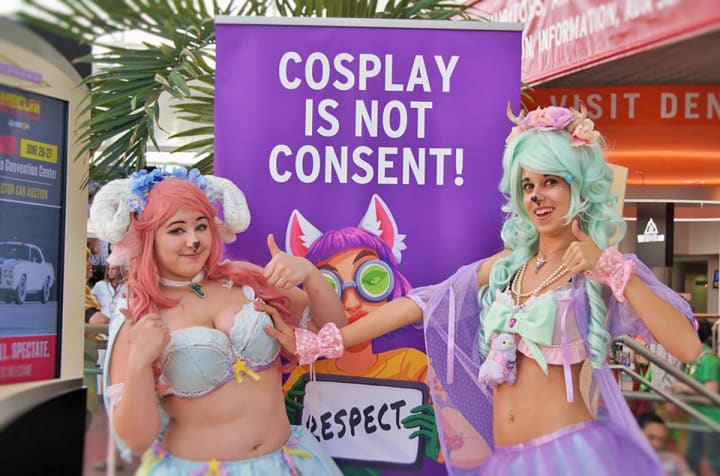Cosplay Is Not Consent
The need for Cosplay is Not Consent casts a dark shadow over the world of cons and cosplay.

The buzz and excitement of a Con is unrivaled by any other geek/nerd/otaku gathering in existence. The single release of even the most popular video game or comic book is only a fraction of the atmosphere of a convention. Before you even get to the convention however, you may notice people around you that are headed to the same event. How do you know that they’re fellow convention-goers? Cosplay of course. At the 2015 New York Comic Con, a large sign stating “Cosplay is NOT Consent” greeted some hundreds of thousands of visitors upon entering the Javits Convention Center. The slogan is a part of a recent movement to end sexual harassment and tasteless treatment of cosplayers (mostly female) that may or may not be sporting revealing costumes of their favorite characters. The harassment ranges from the creepy but somewhat harmless photos without permission, to the full blown stalking, and even sometimes, sexual assault.
As far as the numbers are concerned, Janella Asselin found in a self-reporting study circulated online that of 3,600 responses, 13 percent reported “having unwanted comments of a sexual nature made about them at conventions.” She also found that 8 percent of people (both male, female, and non-binary responders) reported that they had been groped, assaulted, or raped at a comic convention. Asselin provides perspective of these results: “If eight percent of San Diego Comic-Con attendees are groped, assaulted, or raped, that’s over 10,000 attendees suffering harassment.”

Photo via flickr
Un-Con-Ventional Safety
It would seem that conventions as of late have gone to certain lengths to combat these reports with plenty of advertisements and information (and even panels) about harassment policy for the conventions. Comic-con in particular (in both San Diego and New York as of 2015) has implemented zero tolerance policies for harassment of any kind.
Enforcement of the policies however, is another story. If you do a quick search of Poison Ivy cosplay, you are likely to find a host of professional photos of professional cosplayers dressed up in somewhat revealing pieces. It makes sense – Poison Ivy is known for her sex-appeal as a character. However, keep scrolling through the photos, and you may wind up finding candid and somewhat creepy shots of unsuspecting cosplayers at conventions.
So far, the response to the issue has focused on awareness and protection for cosplayers. Addressing the issue and increasing visibility is helpful, sure, but what about the underlying culture that contributes to and creates the unique prevalence of up-skirt shots and photos without permission? What is it about the geek/fandom community that makes conventions and cosplay its own “hunting ground?”

Infographic via alis-alley.com
Who Watches the Watchmen?
In what is potentially a chicken or the egg situation, it seems that both media and the personality perpetrators of the harassment compound to contribute to the problem. It is no secret that comics, video games, anime, and many other forms of media all have problems with the representation of women. It’s easily seen in the various movements that have surfaced in response to the sexism (ex: the Bechdel test) that when it comes to female characters, there’s a tendency for the women to be treated as objects, as prizes to be won, or to serve no purpose beyond being sexually attractive.
Ultimately, this constant bombardment of treating women nothing like the fully developed human beings that their male counterparts are treated as could lead to a dangerous subconscious idea about women at conventions. Admittedly, the link is complicated because there’s an argument that media is not reality and that quite a few people have the ability to realize this.

Photo via crazy4comiccon.wordpress.com
But to ignore the ways in which media, courtesy of technology, has blurred the lines between the media/art we consume and the real lives that we lead. For some men, as Stephen Lerche in The Guardian claims in his investigation of the Men’s Rights Reddit group "The Red Pill", “there is violence hidden under the virtue.” On the surface, an average gamer or comic book reader may be endlessly exposed to female characters that usually sport outfits that are skimpy or are drawn in a way to appear more sexually attractive. When this portrayal is coupled with no activity beyond being a character for the male hero to rescue, it becomes (at least perhaps subconsciously) easier to see a regular girl that is choosing to dress up like that character in a similar manner.
A Social Script of Frustration and Harassment
But this explanation doesn’t work on its own because there’s no evidence that consumption of certain media alone will automatically make you treat women as worthy of harassment. There also has to be a psychological (a combination of the environmental and biological effects on a person) component. If you think of those men of the geek communities as potentially more likely to be awkward and used to women not within their geek fandom being uninterested, they might be overjoyed when they finally meet a woman who appears to be “in their league.” Unfortunately, they might be equally likely to harass or assault a woman who disrupts their line of thinking that women with similar interests should immediately reciprocate their feelings.
Dr. Noam Shpancer describes this situation as a social script. In this case, the script is that by that women who resemble the women male geeks admire from their favorite anime, comic books, or video games, and like the things that male geeks enjoy, will reciprocate sexual advances. When a woman deviates from this script, it is met with outrage and violence.

Image via Deviant Art user shadowchecker
As for where this social script comes from, it could be what the media perpetuates, or it could also be media in combination with the biological origins of sexual aggression. Hence, chicken or the egg? Upon considering the role of sexy cosplayers, it becomes clear that the origins of the social script matters only in its ability to prevent men from believing that all women must submit to it.
Cosplay is arguably both for the cosplayer and for those who like to look at cosplay. In the same way that a fashion designer loves to design for herself and also loves to design for others, cosplay contains a presentation element. Some female cosplayers, like underwear models, have begun to capitalize on their ability to attract attention for their sex appeal through cosplay.
These women are perhaps even more likely to experience harassment because of that same social script – the one that says sexy geek women will go along with geek men because that’s what they’re supposed to do. But just because they appear to be more likely to follow that social script, doesn’t mean that they should or that they have to.
Cosplay as a Vehicle of Consumption
That is to say, even though sexy cosplayers might provide a service to consumers with their outfits, photos, and posing, they are just like any male celebrity playing your favorite superhero. They are a human being and their job is not anything more than what they say it is.
It’s likened to the difference between a stripper and a prostitute. You cannot make the assumption that a stripper will offer you sex or be subjected to sexual advances just because their occupation is relevant or is sexually charging. It would be like asking a bar owner that doesn’t serve wine to serve it just because other bars do.
Ultimately, the problem of what causes sexual harassment and assault appears to be a complex interaction between geek culture, rape culture, and biological origins of aggression; and women (and victims of all forms) cannot be responsible for the actions of their perpetrators. To assume otherwise is to subscribe to the idea that if you think or feel you are entitled to something, you must react with aggression if another person thwarts that thing.
Going back to Marche’s investigation of the "Red Pill Reddit" group, the context of harassment at conventions, particularly of women wearing cosplay, is that the more women are making themselves present in the community, the more threatening they might appear. The threat is not that women will encroach upon their space as much as it is a situation that male geeks might not be prepared for.

Image via moviepilot
Red Pill Philosophy
But "Redpillers" are responding to a much more novel and contemporary reality than such biological imperatives: they are responding to women having financial and sexual power over their own lives and bodies. And they haven’t dealt with it yet. The term “manosphere” is really a misnomer. ‘Not-quite-a-manosphere’ would be better.” The geek example would be that conventions are now not just full of dorky men getting to fanboy over the newest slate of Marvel babes and anime best girls. They now have to also deal with fangirls who share the interest, but are not obligated to be like their virtual female counterparts. Matthew Patrick of the Game Theorists recently analyzed the authenticity of dating simulator games, posing the question of whether you can actually learn tips from them. While he creates a very convincing argument for the authenticity of certain games, it’s important to remember that a game is programmed for a positive response after a certain set of actions. Humans are much more complex and thus, no matter a girl’s sexy cosplay, or sexy anime pictures seem to imply, it cannot be equated to consent.
Learn about the trials and tribulations of professional cosplay through Heroes of Cosplay. This reality show shows several professional cosplayers as they make their way through the con scene.
About the Creator
Tara Edwards
New York based freelance writer and story master at the 8-Player Pictures film company. You can find her blogging about anime, video games, and life philosophies on findtaraedwards.wordpress.com or tweet her @findtaraedwards.






Comments
There are no comments for this story
Be the first to respond and start the conversation.